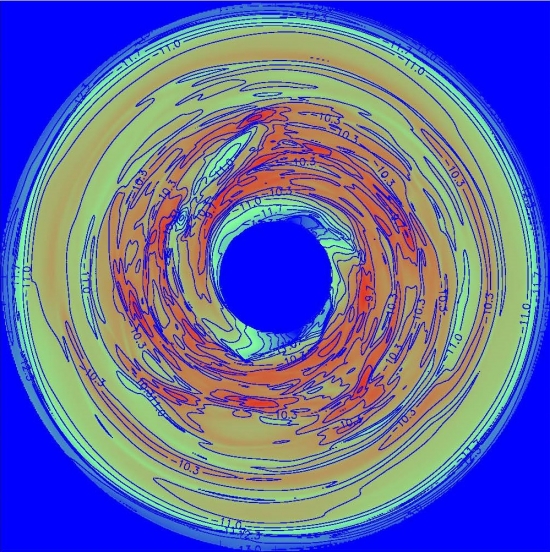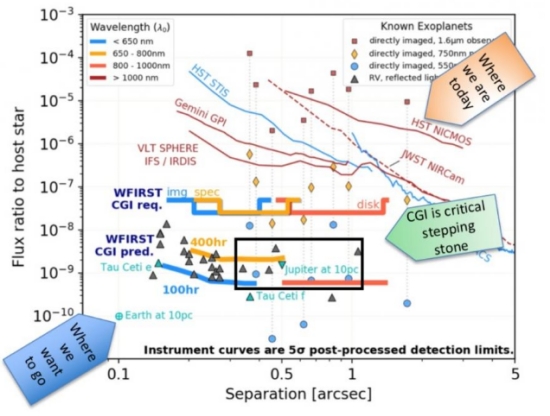The news of a gas giant of half Jupiter’s mass around a small red dwarf, GJ 3512 b, continues to resonate. It goes to what has become a well enshrined controversy among those who follow planet formation models. While core accretion is widely accepted as a way of building planets, gravitational instability has remained an option. We are not talking about replacing one model with another, but rather saying that there may be various roads to planet formation among the gas giants. In any case, GJ 3512 b makes a strong case that we have much to learn.
When I think about gravitational instability, I go back to the work of Alan Boss (Carnegie Institution for Science), as he has long investigated the concept. I learned about it from his papers and his subsequent book The Crowded Universe (Basic Books, 2009). Here’s how Boss describes it there:
Proponents of the top-down mechanism… envision clumps of gas and dust forming directly out of the planet-forming disk as a result of the self-gravity of the disk gas. The clumps would result from the intersections of random waves sloshing around the disk, waves that look much like the arms in spiral galaxies such as the Milky Way. When two spiral arms pass through each other, they momentarily merge to form a wave with their combined heights, just as waves do on the surface of an ocean. Such a rogue wave might rapidly lead to the formation of a clump massive enough to be self-gravitating, and so hold itself together against the forces trying to pull it apart. Once such a self-gravitating clump forms, the dust grains within the clumps settle down to the center of the protoplanet and form a core…
What emerges, then, is a solid core with gaseous envelope. In other words, this ‘disk instability’ model produces a planet that has the same structure as one derived from core accretion. What makes GJ 3512 b so interesting is that its position around a star as small as its host is hard to explain without a truly massive disk, and if that disk were to form, it would be unstable, and the gravitational instability model could come into play. The creator of this model, by the way, is Alastair Cameron (Harvard University), who spawned the notion in 1972. Other key players were Gerard Kuiper and Soviet scientist Victor Safronov, though it was Boss who revived the idea in 1997 and began developing computer models showing how it could occur.

Image: Simulation of the disk of gas and dust surrounding a young star. Credit: Alan Boss.
So what does Boss think of GJ 3512 b? As you might guess, he’s energized by the result:
My new models show that disk instability can form dense clumps at distances similar to those of the Solar System’s giant planets. The exoplanet census is still very much underway, and this work suggests that there are many more gas giants out there waiting to be counted.”
The work he is referring to is a new paper in press at The Astrophysical Journal that suggests there is a likelihood that gas giants in Jupiter-like orbits may be plentiful, with the inherent biases built into our observational techniques making them hard to find. As for how many of these may be formed from disk instability, Boss is computing various protoplanetary disk models to continue the investigation. As he notes in the new paper:
These models are intended to be first steps toward creating a hybrid model for exoplanet population synthesis, where a combination of core accretion and disk instability works in tandem to try to reproduce the exoplanet demographics emerging from numerous large surveys using ground-based Doppler spectroscopy and gravitational microlensing or space-based transit photometry (e.g., Kepler, TESS).

Image: The black box encapsulating Jupiter denotes the approximate region of exoplanet discovery space where Alan Boss’ new models of gas giant planet formation suggest significant numbers of exoplanets remain to be found by direct imaging surveys of nearby stars. NASA’s WFIRST mission, slated for launch in 2025, will test the technology for a coronagraph (CGI) that would be capable of detecting these putative exoplanets. Top Right: This simulation of the disk of gas and dust surrounding a young star shows dense clumps forming in the material. According to the proposed disk instability method of planet formation, they will contract and coalesce into a baby gas giant planet. Credit: Alan Boss.
We’re slowly eking out planets in wider orbits that are tricky for radial velocity, where their signals are more difficult to tease out than large planets close to their star, and also for transit work, because the transits would occur over an orbital period of five years or more. Boss continues to champion the concept that one size may not fit all when it comes to planet formation, with GJ 3512 b a striking case in point. Given a sufficiently massive protoplanetary disk, giant planets form in his models within 20 AU. Another targeted investigation for WFIRST will come out of all this when the mission launches some time in the next decade.
The paper is Boss, “The Effect of the Approach to Gas Disk Gravitational Instability on the Rapid Formation of Gas Giant Planets,” in press at The Astrophysical Journal (preprint).



I like the gravitational disk instability idea since it is logical to assume that the gas and dusk clumps would have to be the fastest or start first considering the idea of the combined and increased wave amplitude of the cloud, so the pebbles would be pulled into the clumps after they formed which are gravitationally attractive and would gobble up the pebbles the fastest.
Paul: I know that you are a very very busy man right now, but in case you do have some available time in the near future, you may want to ask Dr Boss about a possible new scenario that has just recently popped up – two co-orbital giant planets forming DIFFERENTLY, othe more massive one via disk instability, and the other via core accretion. This is a new scenario put forward to explain Kepler 1625b 1, should it actually exist. Go to the http://www.portaltotheuniverse.org Featured News section to check it out. Also, should Kepler 1625b 1 actually exist, it would be a slightly more massive analog to K2-18b, and E-ELT should be able to detect water in its atmosphere despite being `8.000 light years away.
Can’t do this right now, Harry, but will keep it in mind for the future.
Harry, this is the most recent news item I could find on Kepler 1625b-1, going through the site you linked to:
Exomoon, or No Exomoon?
By Susanna Kohler
24 June 2019
https://aasnova.org/2019/06/24/exomoon-or-no-exomoon/
Is this what you meant, or another news item?
Sorry. It is actually in the Blogs section BELOW the Featured News section. Scroll down to the(currently – this is subject to change)SECOND ILLISTRATED blog.
Ah, this one:
Neptune-Size Exomoon Candidate May Be the Captured Core of a Giant Planet
By Mike Wall 2019-10-02, 18:01:05
The mysterious Kepler-1625b-i and its parent planet may once have been siblings.
https://www.space.com/neptune-size-exomoon-giant-planet-core.html
My question: Does the recent discovery via the Juno orbiter that Jupiter’s core may not be the solid ball of (Earth-sized) rock scientists once assumed it was apply to all other Jovian style worlds in the galaxy and beyond? Or is each case unique?
What I am saying is if Jupiter does not have a solid core and this presumed sibling world was also a Jovian-style planet, why would it have an intact core? And what about the cores of Saturn, Uranus, and Neptune while we are it?
And now the paper(just up on the exoplanet.eu website. Science Advance: DOI 10.1126/sciadv.aaw8665 “Formation of exoplanetary satellites by pull down capture”. by Bradley M. S. Hansen. This is the most plausible way that systems like the putative Kepler 1625b – Kepler 1625b 1 can form. And while we are at it, this is the most plausible way extremely eccentric trans-Kuiper Belt planets like the putative Planet Nine and Fomalhaut b can get where they are: Stellar Flybys Interrupting Planet-Planet Scattering generates Ooet Planets”. by Nora Bailey and Daniel Fabrycky. This one is paywall right now, but I expect it to be up on the exoplanet.eu website very soon.
Try this.
Sifting through the mountains of data with a variety of models derived from different paradigms, may, by sorting the wheat from the chaff – the signal from the noise – occasionally offer faint glimpses resembling what is sought.
It is to be hoped that a continuance of the effort with the addition of newly-acquired finer-grained data will shift some concepts from speculation into consensus.
I think there still is a solid core with the disk instability model, but this model assumes a much faster core growth from the protoplanetary disk, than the core accretion models used for the inner planets. All gas giants would have to form the same way.
I wouldn’t think that “all gas giants would have to form the same way” is a safe assumption Geoffrey. The universe and all that is in it is way too varied. There are good, sound reasons to expect that both core accretion and disc instability work to build giant planets in different systems, and possibly even in the same system.
I already said that. You could be reading more into “the same way.” It may be that the dust combines into pebbles early in the protoplanetary disk so that the clumps contain both dust and pebbles and we get a massive enough clump to pull in more dust and pebbles with gravity and that process increases with the accumulation of mass and gravity so the birth of the protoplantary gas giant is complete before the Star is born. The planet is large enough to hold onto hydrogen and helium at low temperature before the star is born. It keeps attracting more H, and He as the gravity increases.
To an outsider it seems surprising that these simulations are so limited. The paper talks about several simplifying approximations in the physics, a polar coordinate grid that is apparently 200 x 23 x 1024, and no more than 16,000,000 particles. Is there a way to throw more computational power at the problem? Start an @Home project, sell sponsorships payable in computing time to major internet corporations, or start a cryptocurrency where proof-of-work is done by simulating a large number of particle-particle interactions and then you go back and audit three particles at random? (It would be nice if the greedy miners emitting nation-sized carbon footprints were at least crunching astronomy numbers)
Also, how do these models interact with exotic particles? Monopoles, primordial black holes, WIMPs etc. … can they nucleate entire planets? Do they all get swept up into the core of Jupiter, or can you predict orbits to go prospecting for them?
The models are an attempt to predict observations of protoplanetary disks as seen from the telescope: https://centauri-dreams.org/2018/12/07/exoplanet-candidates-in-12-protoplanetary-disks/
Exotic particles and black holes are not common so they don’t need to be included in the models. I assume the dust and gas does get swept up by a gas giant early or even before the star is born when the dust and gas is blown away. This might make it possible for gas giants to form near stars without migration. The disk instability theory predicts that large gas giants like Jupiter can only form in the outer regions of the solar system. I don’t know what the principles that are used to support such a prediction. It could be time, heat, gravity or angular momentum. It would be nice to see a young protoplanetary disk with a large gas giant size body near the star if possible. I can’t think of a reason why the disk instability model can’t predict the formation of a gas giant near a star which seems easier and more probable than planetary migration.
NEWS ALERT: Mayor and Qeloz FINALLY won the Nobel Prize in physics for the first CONFIRMED discovery of an exoplanet orbiting a main sequence star. YAAAAAAAAY!!!!! About time.
And it only took the Nobel committee 24 years to honor them. And they left others out. And if you are dead, forget it, no honors for you.
This reward system is antiquated and needs a major overhaul. But so long as it is seen as a career maker, those who stand to benefit from it will do little to nothing to change things.
I have always been lead to believe that any pre-Starshade/NWO JWST search for planets around Alpha Centauri A or Alpha Centauri B were not feasible because both stars are so luminous in the infra-red that they would OVERWHELM JWST’s sensitive equipment sans coronograph. Guess I was wrong! Arxiv:1910.09709. “Searching for Planets Orbiting Alpha Centauri A with the James Webb Telescope.” by Beichman et al. ALSO, NEAR results were “promised” by the end of October. Getting pretty close.